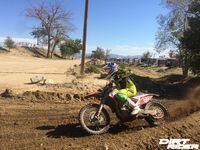The 24hrs of Glen Helen has always held a special place in my heart, from being on fast teams, to iron manning it (bad idea), I always end up racing it one way or another. But this year, racing the JBC 24hr had an all new objective - not necessarily to win, but to gather data for the Kurt Caselli Foundation. About a week before the race I received a call from Quinn Cody asking if I would be interested in racing on a factory KTM 450 XC-F with the Foundation to gather some safety data. I replied, “Does a bear [uh, ‘walk’] in the woods?” He took that as a yes and told me he’d see me at the track on race day.
Upon arriving at the track I was told the whole team, which consisted of Ivan Ramirez, Eric Yorba, Jesse Zeigler, Skyler Howes, Brad Baker, and myself would be subject to cognitive tests before and after the race. To my surprise, these tests were anything but easy, they started with simple balance tests where we were asked to stand on our non-dominate foot, put our hands on our hips and close our eyes for 20 seconds. This was followed up by similar balance tests on and off of a foam mat before we moved on to the Cranial Nerve, memory and reaction time tests. The Cranial Nerve tests systematically examine functions that are associated with identified anatomy in the brain and spinal cord. The examination focuses on twelve large nerves, called the cranial nerves, which arise from groups of cells called nuclei in the brainstem. These cranial nerves serve narrowly defined functions such as reflexive eye blinking and movement of the tongue during chewing. These tests basically consisted of doctors looking into our eyes, holding a light, and moving our heads back and forth while we focused our eyes on a fixed point. The last two tests were the hardest, epically to someone, like myself, who hadn’t taken any tests (aside from enduro specials) in years. We were shown charts, one had 1-10 and below that were symbols that represented each number. We were then only given the symbols and told to fill in the blank boxes with the numbers that the symbols represented. Let me tell you, this sounds easy but man it can make you feel less than brilliant. Then final test was reaction time, we were told to hold our finger on an orange dot (on an iPad) and when the green dot appeared we were supposed to touch the green dot then return our finger to the orange dot which was fairly easy.
After racing 24 hours, 86 laps, and 602 miles, our team had not only finished the race while gathering valuable research, but won the business class in the process finishing 10th overall. As luck had it I ended up being the last rider on the bike, meaning I would have to take the tests again as soon as I got off of the bike. I want to emphasize just how hard those same tests were after getting off of a factory 450 after racing for an hour and twenty minutes. The balance tests made me feel inebriated, the memory tests were quite challenging, and the symbol tests made me feel like a child. The doctors need to compile all of the information but they did tell me that they could tell a difference in my cognitive function after racing. The goal of these tests was not to check for major concussions but for small minor ones from the jarring the body takes while racing. Keep an eye out for an upcoming article when the information from the doctors and sensors are compiled and given to the foundation.

/cloudfront-us-east-1.images.arcpublishing.com/octane/KQUVDTNB6VF53CRDNN47BE3VUA.jpg)
/cloudfront-us-east-1.images.arcpublishing.com/octane/3T32INAZQRGPXOGGA36NQJDSSM.jpg)
/cloudfront-us-east-1.images.arcpublishing.com/octane/EPLS5PBKXBHNXK7S5O7G4ND3YQ.jpg)
/cloudfront-us-east-1.images.arcpublishing.com/octane/MNGOZAGZFZBH5DPFV7NOPF5S3Y.jpg)
/cloudfront-us-east-1.images.arcpublishing.com/octane/VGJWIIFM2VBCXG34KRQ37GCP7U.jpg)
/cloudfront-us-east-1.images.arcpublishing.com/octane/2ZU3HXRPMZESJF7HDLZJV7FHEY.jpg)
/cloudfront-us-east-1.images.arcpublishing.com/octane/VVFWQBZEIZDVJHZIW5ISKWKOZU.jpg)
/cloudfront-us-east-1.images.arcpublishing.com/octane/7T7FZXHIIBDX7AOBD5S3IICUJI.jpg)
/cloudfront-us-east-1.images.arcpublishing.com/octane/T3Y7A52TXBEBJNEPGOQSVPQSPU.jpg)
/cloudfront-us-east-1.images.arcpublishing.com/octane/KY33U3WBTNFIBJFMTEF2SM7BOQ.jpg)
/cloudfront-us-east-1.images.arcpublishing.com/octane/JNPS5MGVXJC7BARVMARYQIQHXE.jpg)
/cloudfront-us-east-1.images.arcpublishing.com/octane/63N2P6SYAZDURJDO5KARQYX2J4.jpg)
/cloudfront-us-east-1.images.arcpublishing.com/octane/C72WX35SXFETTO5OVA2RWT523I.jpg)
/cloudfront-us-east-1.images.arcpublishing.com/octane/F3ER37EV2RGY5CRYFNTWE3JSF4.jpg)
/cloudfront-us-east-1.images.arcpublishing.com/octane/L65QCUR32RH2NKCUHXYHHAPDFI.jpg)
/cloudfront-us-east-1.images.arcpublishing.com/octane/VSK246VVRRDMBNQU7B2NTNY6AE.jpg)
/cloudfront-us-east-1.images.arcpublishing.com/octane/CG64RRFAYRENNAP2AA22T2LSJY.jpg)
/cloudfront-us-east-1.images.arcpublishing.com/octane/IKZSRLBWMRDORMORBXSISL4D6M.jpg)
/cloudfront-us-east-1.images.arcpublishing.com/octane/BJLVRPJSDFC3ZLPMW3LYYHMPZE.jpg)
/cloudfront-us-east-1.images.arcpublishing.com/octane/RQW2RFU4MJDYRPVFJNW362SEXU.jpg)
/cloudfront-us-east-1.images.arcpublishing.com/octane/CGQDU7HEEBBWBLF6SMXCJIW7DI.jpg)
/cloudfront-us-east-1.images.arcpublishing.com/octane/B35XXACE4ZGU5BWSEMEFUL6SN4.jpg)
/cloudfront-us-east-1.images.arcpublishing.com/octane/TDSGY4VSSRC4LP6PYXP62U236Y.jpg)
/cloudfront-us-east-1.images.arcpublishing.com/octane/4YWNAG64EZF63AQI3VL7ANERSY.jpg)